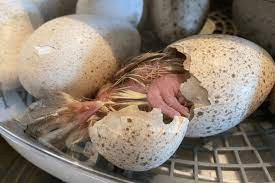Proper handling and storage of hatching eggs is essential for maintaining their quality and maximizing hatchability. Here are some guidelines for handling and storing hatching eggs:
- Collect eggs frequently: Hatching eggs should be collected from the nest boxes at least twice a day to prevent the eggs from becoming soiled or contaminated.
- Handle eggs gently: Eggs should be handled gently and with care to prevent damage to the shells. Avoid dropping, shaking, or rolling the eggs.
- Clean eggs: Eggs should be cleaned if they are soiled or dirty, but only using clean water at a temperature of about 38°C to prevent contamination. Do not use detergents or soaps as they can damage the cuticle on the shell and make the egg more vulnerable to bacterial infection.
- Allow eggs to settle: After collecting and cleaning the eggs, allow them to settle for several hours at room temperature to stabilize the air cell inside the egg.
- Store eggs properly: Hatching eggs should be stored in a clean, cool, and well-ventilated room with a temperature range of 12°C to 16°C and humidity between 70% and 80%. Eggs should be stored in egg trays with the pointed end of the egg downwards. This helps to keep the air cell in the correct position and prevent the embryo from sticking to the shell.
- Turn eggs: Eggs should be turned at least three times a day during storage, preferably more frequently. This helps to prevent the yolk from settling to one side and sticking to the shell, which can impair the embryo’s development.
- Use eggs within a week: Hatching eggs should be used within a week of collection for maximum hatchability. After a week, the hatchability starts to decline due to embryo aging.
Proper handling and storage of hatching eggs can help to maximize hatchability and produce healthy and vigorous chicks.

